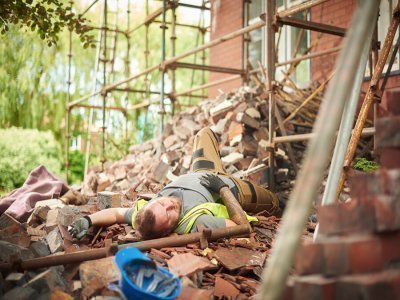Fall Prevention Under The Microscope – Recalibrating What Is Reasonably Practicable
WorkSafe inspectors in Victoria are checking construction sites to make sure fall risks are being controlled including if scaffolds are safe and fit for purpose. Construction is a known high fall risk sector accounting for 37% of falls-related fatalities however all workplaces where falls are a risk need to consider their controls. Sadly, according to Safe Work Australia, more than one in 10 work-related fatalities are caused by a fall from height and, as recently as the 3rd February this year, a serious accident involving scaffolding was in the news.
A large section of scaffolding around a three-storey building site in Craigieburn, Victoria collapsed with five men hurt, two seriously. The cause of the collapse is unknown but WorkSafe is investigating. WorkSafe Victoria's chief of business operations Marnie Williams said it would be "a complex investigation" and any applicable charges would be laid within 12 months. This follows an incident in Sydney in 2019 when an 18 year old tradie was crushed to death when scaffolding fell on him.
Sobering Fall Statistics
Between 1 January 2003 and 31 December 2015, from Safe Work Australia:
- 359 workers killed following a fall from a height—11% of all workers killed over this period
- Half of these falls involved falling three metres or less
- The greatest number of fatalities were falls from roofs (59), ladders (54), vehicles (27) and horses (33)
- Workers aged 45 years and over made up 65% of those who died
- The construction industry accounted for 37% of falls-related fatalities
Whilst these figures indicate over a third of all falls occur in the construction industry we know high severity falls occur in all occupational settings with fall risks e.g: slippery, cluttered or unstable walking/working surfaces; unprotected edges; floor holes and wall voids; unsafely positioned ladders; and misused fall protection.
Common Causes of Falls
The most common fall incidents on a construction site have been found by WorkSafe Vic to be:
- Working on or near unprotected edges
- Using unsafe or incomplete scaffolds
- Using inappropriate ladders or unsafe ladder use
- Falling from roofs or through fragile roofs or skylights
- Falling from trucks or plant
- Falling through stair-voids
- Falling into holes, pits or shafts
Controlling Falls ‘As Far As Reasonably Practicable’?
Most people are aware that the regulations require duty holders to work through the control hierarchy with ‘reasonably practicable’ as the threshold for action and for some situations the definition of what is ‘reasonably practicable’, involving multiple factors and qualitative assessments, can be difficult to pin down.
After elimination of the risk (e.g. work from the ground) higher order controls include:
- Fall prevention devices e.g. guard rails, scaffolding, scissor lifts;
- Work positioning systems e.g. industrial rope access system, travel restraint systems;
- Fall arrest systems e.g. safety nets, catch platforms.
In assessing these controls the cost can be a significant factor to those on a budget (and who isn’t). To argue for extra expenditure, it may be necessary to drill into the definition of what controls are required under the OHS Acts i.e. what might be determined as ‘reasonably practicable’ under the Act . The factors in the reasonably practicable algorithm are not equally weighted. We are not lawyers at JTA but have been in the OHS industry for many years and over that time have noted a few relevant points to assessing the practicability for higher order controls:
What We’ve Learnt From Experience
We are not lawyers at JTA but have been in the OHS industry for many years and over that time have noted a few relevant points to assessing the practicability for higher order controls:
- Cost of control is downplayed (in WorkSafe Victoria guidance documentation) compared with severity of the risk and suitability of control. Worksafe guidance states that cost is a factor only if “the cost of (control) is so disproportionate to the benefit (in terms of reducing the severity of the hazard or risk) that it would be clearly unreasonable to justify the expenditure”1.
- Most controls that improve safety come with productivity and/or quality benefits. Case in point doing HazMat ceiling inspections from an EWP vs a ladder where the full benefits become obvious in a way that is difficult to appreciate until you give it a try. Access to a greater, more representative area of the building, relative comfort and freedom to move, sample, take better photos, etc. leading to more thorough inspections, missing less HazMats and better result for the client. When these benefits are included the cost may look more practicable.
- And finally, an insight from experience: when looking at the likelihood and severity of an event we rarely have reliable statistics or organisational experience to go on outside large organisations. The real analysis may come after the event. Looking at likelihood and severity after with 20 20 vision of hindsight. Falls and other serious injuries due to unprecedented events can look much more likely after the event. The fact that something has not yet occurred in a particular workplace does not necessarily mean that it does not warrant higher order controls. Fall risks do not start at two metres. Prosecutions can be taken under OHS Act general duties for any fall, even potentially a same level fall. What you know or ought reasonably to know about available controls plays into their practicability and is not restricted to falls from two metres or more. It might be expected that employers, persons conducting a business or undertaking etc. implementing controls for falls over two metres would be expected to know about their relevance to falls of a lesser height.
Scaffold Safety
WorkSafe inspectors in Victoria are also checking scaffolding is and remains safe, and is fit for the task(s) it is being used for. WorkSafe have highlighted the incidents involving scaffolding each year including:
- People falling from scaffolds that are incomplete or have been altered without authorisation
- Scaffold collapse or failure of components due to incorrect assembly, incompatible componentry, overloading or unauthorised alteration (e.g. tie removal)
- People falling from scaffolding due to misuse (e.g. standing on guardrails)
- Objects falling off scaffolds and hitting people below
- Scaffolds being struck by mobile plant or vehicles, or being snagged by a crane
To ensure scaffolding is safe the inspectors will want to see that:
- There is an appropriate footprint for scaffold to be erected
- It is constructed on a stable surface or solid ground that is capable of bearing the imposed loads
- Where required, appropriate ties or other means of stabilisation are used
- It has been erected by licensed scaffolders
It is incumbent on employers or PCBUs to ensure policies and procedures line up with OHS or WHS legislation in your state to eliminate or minimise the risks that can lead to a dangerous fall.
We have expert OHS Consultants qualified and experienced in the development of practical OHS Management Systems and who can assist you to comply with safety legislation in your State.
1 How WorkSafe applies the law in relation to Reasonably Practicable WORKSAFE POSITION A GUIDELINE MADE UNDER SECTION 12 OF THE OCCUPATIONAL HEALTH AND SAFETY ACT 2004









